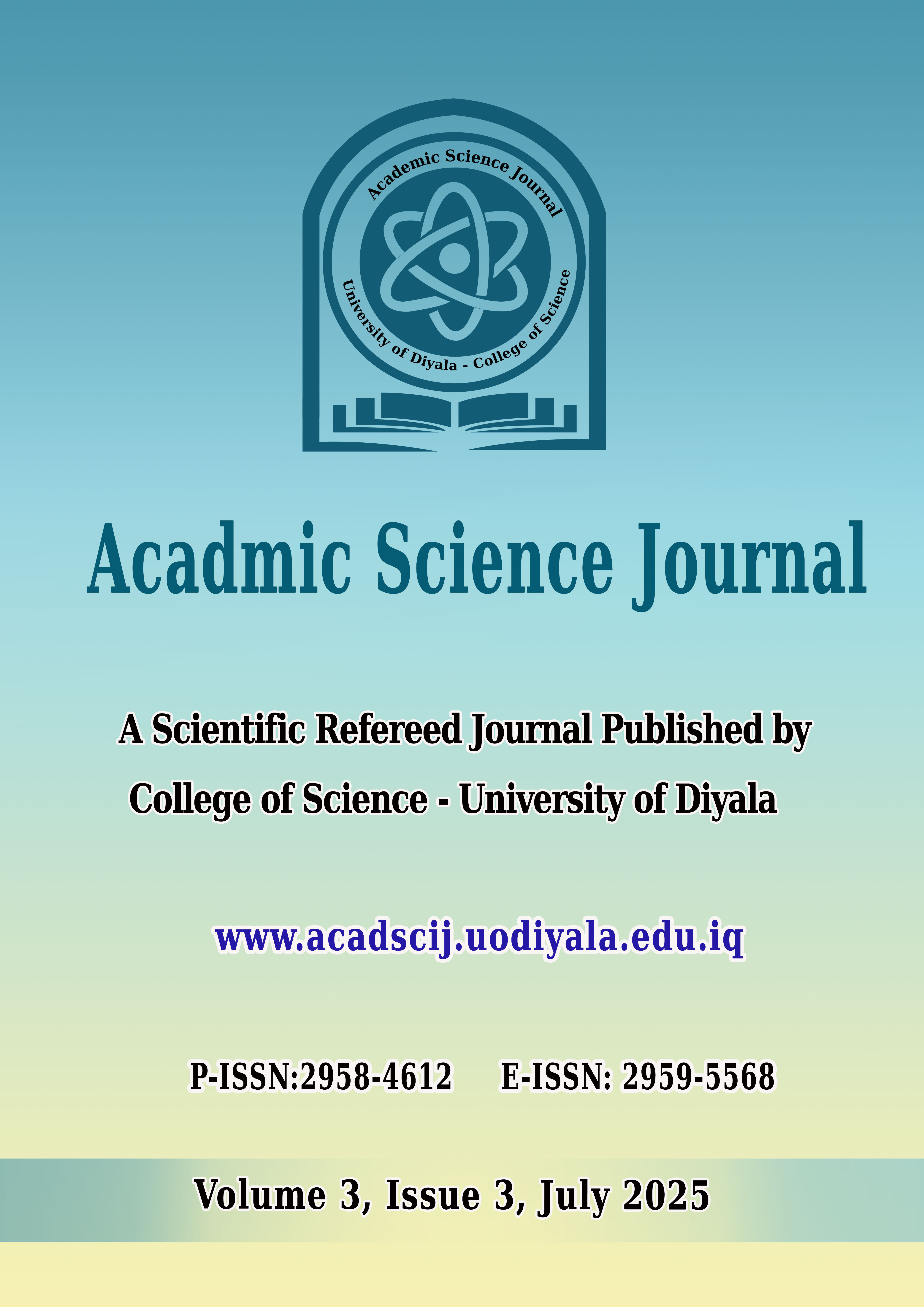Investigate the Effectiveness of Plants Grown Alongside the Roads of Baqubah City for Phytoremediation of Nickel
Testing the efficiency of some plants grown on the roadsides in Baqubah city as a phytoremediation of nickel
DOI:
https://doi.org/10.24237/ASJ.03.03.869BKeywords:
Heavy metals , Nickel, Phytoremediation , pollutionAbstract
Heavy metals are classified as non-degradable contaminants, which are considered to be among the most harmful to the environment. Samples for the research were obtained in September (2022). In this research, the ability of five species of plants grown on roadsides in the city of Baqubah - Diyala province to remove nickel from the environment (soil, air and water) was tested.The study aimed to evaluate the responsibility of various plants grown along The roadside in nickel bioremediation by estimating the concentration of nickel in the plants' leaves and soil, as well as computing the Bioaccumulation Factor (BAF).The plants used in the study were: Nerium oleander, Eucalyptus camalduulensis, Albizia lebbeck, Ficus nitida, and Callistemon viminalis species from three different locations in Baqubah city were: the industrial area, Hospital street and Al-Mustafa neighborhood. The results indicated substantial variances across the different plant types. It also showed that the soil is not polluted with nickel, compared with the natural abundance of the element in the Baqubah city, and the global average for uncontaminated soil.The C. viminalis plant was better for phytoremediation in all regions than other plants, while the other plants varied in their ability to phytoremediation of nickel. All study areas were uncontaminated to moderately contaminate with nickel and located in Class1 of Igeo classification.
Downloads
References
[1] World Health Organization (WHO). Nickel: environmental health criteria, 108: World Health Organization, Geneva (1991)
[2] K. Takishima, T. Suga, G. Mamiya, The structure of jack‑bean urease, The complete amino‑acid sequence, limited proteolysis and reactive cysteine residues, Eur. J. Biochem., 175, 151–165(1988), DOI(https://doi.org/10.1111/j.1432-1033.1988.tb14177.x)
[3] M. Cempel, G. Nikel, Nickel: a review of its sources and environmental toxicology, Pol. J. Environ. Stud., 15, 375–382(2006), DOI(https://doi.org/10.4236/ojss.2025.152006)
[4] B. Valko, H. Morris, M. T. D. Cronin, Metals, toxicity and oxidative stress, Curr. Med. Chem., 12(10), 1161–1208(2005), DOI(https://doi.org/10.2174/0929867053764635)
[5] K. V. Brix, C. E. Schlekat, E. R. Garman, The mechanisms of nickel toxicity in aquatic environments: an adverse outcome pathway analysis, Environ. Toxicol. Chem., 36(5), 1128–1137(2017), DOI(https://doi.org/10.1002/etc.3706)
[6] T. Kumar, R. Mohsin, M. F. A. Ghafir, I. Kumar, A. M. Wash, Concerns over use of leaded aviation gasoline (AVGAS) fuel, Chem. Eng. Trans., 63, 181–186(2018), DOI(https://doi.org/10.3303/CET1863031)
[7] M. Ristić, A. Perić‑Grujić, D. Antanasijević, M. M. Ristić, M. A. Urošević, M. Tomašević, Plants as monitors of lead air pollution, Pollutant Dis. Remed. Recycl., 4, 387–431(2013), DOI(https://doi.org/10.1007/978-3-319-02387-8_8)
[8] S. Norouzi, H. Khademi, Source identification of heavy metals in atmospheric dust using Platanus orientalis L. leaves as bioindicator, Eurasian J. Soil Sci., 4(3), 144–152(2015), DOI(https://doi.org/10.18393/ejss.2015.3.144-152)
[9] S. H. Abed, M. H. Rathi, T. J. Kadhim, Determination of levels of lead and cadmium in canned fish and meat imported to local markets of Diyala Province, Iraq, Earth Environ. Sci., 790, 1–8(2021), DOI(https://doi.org/10.1088/1755-1315/790/1/012043)
[10] H. S. Abdulhay, M. H. Rathi, Lead, cadmium and nickel contamination of roadside soils and plant leaves in Baghdad City, J. Chem. Pharm. Res., 9(8), 47–51(2017)
[11] G. Wu, H. Kang, X. Zhang, H. Shao, L. Chu, C. Ruan, A critical review on the bio-removal of hazardous heavy metals from contaminated soils: issues, progress, eco-environmental concerns and opportunities, Journal of hazardous materials, 174(1-3), 1-8(2010), DOI(https://doi.org/10.1016/j.jhazmat.2009.09.113)
[12] B. Viard, F. Pihan, S. Promeyrat, Determination of micro‑ and macro‑elements by flame atomic absorption spectrometry, Chem. Educator, 21, 264–272(2016)
[13] H. I. Mustapha, H. A. van Bruggen, P. N. L. Lens, Vertical subsurface flow constructed wetlands for the removal of petroleum contaminants from secondary refinery effluent at the Kaduna refining plant (Kaduna, Nigeria), Environ. Sci. Pollut. Res., 25(30), 30,451–30,462 (2018), DOI(https://doi.org/10.1007/s11356-018-2996-9)
[14] G. Muller, Speciation and assessment of heavy metals in surface sediments of Jinjiang River tidal reach, southeast of China, Umschav, 79, 133–149(1979)
[15] S. H. Abed, M. H. Rathi, G. I. Khalil, M. E. Taha, Nerium oleander L. as a phytoremediation of heavy metals in Diyala Governorate–Iraq, J. Environ. Earth Sci., 12(9), 32–39(2022)
[16] S. K. Abd Al‑Wahab, The investigation of some heavy metals in the agricultural soil of Diyala Province and treating them with different types of plants, M.Sc. Thesis, College of Educ. Sci., University of Diyala, Iraq, (2022)
[17] S. H. Abed, M. H. Rathi, G. I. Khalil, M. E. Taha, Nerium oleander L. as a phytoremediation of heavy metals in Diyala Governorate – Iraq, J. Environ. Earth Sci., 12(9), 32–39(2022), DOI(https://doi.org/10.7176/JEES/12-9-04)
[18] S. K. Abd Al‑Wahab, The investigation of some heavy metals in the agricultural soil of Diyala Province and treating them with different types of plants, M.Sc. Thesis, College of Education Sciences, University of Diyala, Iraq, (2022)
Downloads
Published
Issue
Section
License
Copyright (c) 2025 CC BY 4.0

This work is licensed under a Creative Commons Attribution 4.0 International License.












